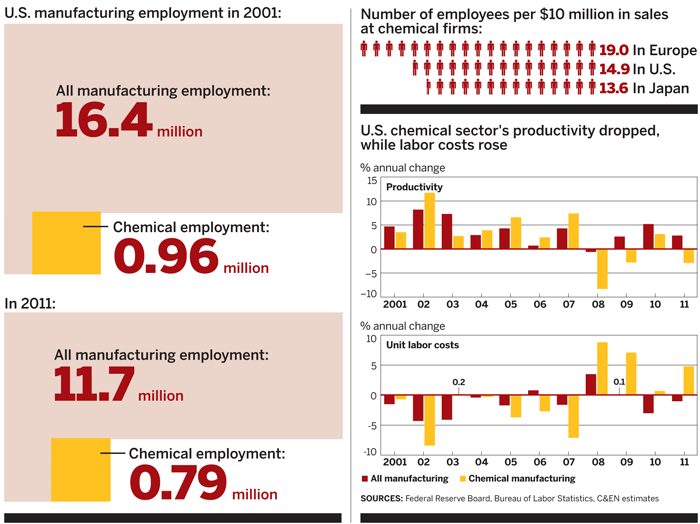Advertisement
Grab your lab coat. Let's get started
Welcome!
Welcome!
Create an account below to get 6 C&EN articles per month, receive newsletters and more - all free.
It seems this is your first time logging in online. Please enter the following information to continue.
As an ACS member you automatically get access to this site. All we need is few more details to create your reading experience.
Not you? Sign in with a different account.
Not you? Sign in with a different account.
ERROR 1
ERROR 1
ERROR 2
ERROR 2
ERROR 2
ERROR 2
ERROR 2
Password and Confirm password must match.
If you have an ACS member number, please enter it here so we can link this account to your membership. (optional)
ERROR 2
ACS values your privacy. By submitting your information, you are gaining access to C&EN and subscribing to our weekly newsletter. We use the information you provide to make your reading experience better, and we will never sell your data to third party members.
Business
Chemical Payroll Rise Is Spotty
Deal-making contributes to employment growth at some major chemical firms
by Business Department
July 1, 2013
| A version of this story appeared in
Volume 91, Issue 26
In 2012, the overall U.S. manufacturing sector saw a modest 1.6% increase in jobs, or 193,000 positions. The uptick did not reach the chemical industry, however, where payrolls were flat overall. And revised statistics from the Department of Labor show that chemical employment decreased by 3,000 workers in 2011 compared with 2010.
COVER STORY
Chemical Payroll Rise Is Spotty
The number of employees at some firms did increase notably in the U.S. as well as in Europe and Japan, but the growth was driven by acquisitions rather than by overall job expansion. For example, Eastman Chemical picked up 3,400 workers when it acquired Solutia. Similarly, Cabot’s purchase of Norit and Cytec Industries’ deal to take over Umeco added to employee counts at those firms.
To download a PDF of the full article and tables, visit http://cenm.ag/empl2013.
In Europe, Linde added the largest number of workers. Of Linde’s 11,600 new hires, more than 10,800 came through its acquisition of the U.S. home health care business Lincare. In contrast, several European firms trimmed staff, including AkzoNobel, Arkema, BASF, Bayer, Clariant, Kemira, Lonza, Merck, and Wacker Chemie.
Japanese chemical firms tracked by C&EN increased employment by nearly 3% in 2012. That figure reflects in large part moves outside Japan. Asahi Kasei, for example, grew by 3,000 when it bought U.S. medical device maker Zoll and expanded chemical operations in Thailand. Japan’s most profitable chemical firm, Shin-Etsu Chemical, acquired a majority stake in a domestic vinyl producer and also expanded operations in China and Vietnam. Overall, the company brought in 1,500 workers.
The chemical industry, which spent most of the 2000s boosting productivity, is now worried about slow global economic growth and is reluctant to hire. Still, in the U.S., the jobs climate has been more stable recently than during the past decade, which saw an average 1.7% yearly decrease in chemical employment.
Meanwhile, the global pharmaceutical industry continued to lay off workers last year, including in R&D positions. Job cuts were announced at AstraZeneca, Novartis, Takeda Pharmaceutical, Johnson & Johnson, Human Genome Sciences, and Sanofi. Pink-slip deliveries can be difficult to track, however, and official U.S. statistics show that pharma employment was unchanged in 2012.
CANADA SHIPMENTS
The Canadian chemical and pharmaceutical sectors both slipped in 2012
CAPITAL SPENDING
Spending surged in Europe, while investments in the U.S. and Japan grew steadily
EUROPE COMPANY RESULTS
Despite the sluggish European economy, revenues increased for most firms
EUROPE SHIPMENTS
The Netherlands and Poland enjoyed Europe's strongest growth
JAPAN COMPANY RESULTS
Sumitomo and Teijin reported large losses in their latest fiscal year
R&D SPENDING
Expenditures grow in chemical firms, but some pharmaceutical companies in the U.S. are cutting back on research and development.
U.S. PRICE INDEX
Prices for paint soared, but overall, chemical product prices grew only slightly
U.S. COMPANY RESULTS
Only half of U.S. chemical and drug firms tracked by C&EN saw profits grow in 2012
U.S. SHIPMENTSOverall chemical shipments were down slightly, but shipments of agricultural and coatings chemicals increased



Join the conversation
Contact the reporter
Submit a Letter to the Editor for publication
Engage with us on Twitter